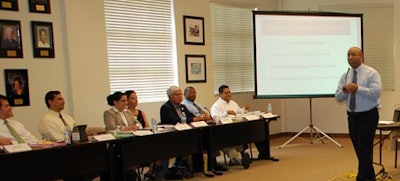 Dr. Luis Ponjuan of Texas A&M, who co-published a report in 2009 that highlighted alarming graduation statistics for Hispanic males, leads a discussion at a recent consortium meeting. (Photo by Dr. Victor Saenz)
Dr. Luis Ponjuan of Texas A&M, who co-published a report in 2009 that highlighted alarming graduation statistics for Hispanic males, leads a discussion at a recent consortium meeting. (Photo by Dr. Victor Saenz)This summer marked the beginning of a collaborative initiative in Texas to link together several community colleges and four-year universities and a couple of school districts in the name of finding solutions to lagging graduation rates among Latino and African-American males. Headed by Dr. Victor Sáenz, associate professor of educational administration and executive director of Project MALES (Mentoring to Achieve Latino Educational Success) at the University of Texas at Austin, the Texas Education Consortium for Male Students of Color is supported by a three-year $335,000 grant and will serve as a platform for dialogue on the issue of college success among minority males.
“The consortium is serving as a professional networking community where all these institutions can come together, learn from each other and understand which strategies may be working with various populations from one end of the state to the other. And ultimately, we’ll glean from that research-based or empirical evidence about the efficacy of each initiative,” said Sáenz, of the 14 members involved, including his own lead school, UT Austin, Texas A&M University, Austin Community College, Austin Independent School District, La Joya Independent School District, Texas State University, University of Texas at San Antonio, El Paso Community College District, Lone Star College System (CyFair and North Harris), Palo Alto College, San Antonio College, South Texas College, Tarrant County College District, University of North Texas (Denton) and Northeast Lakeview College. Ohio and Georgia have similar organizations, but the Texas collaborative is different because it encompasses K–12 districts too.
“Every institution will have a base that focuses on male students of color by the end of the first year, but more than that, besides having something in place: Are these initiatives working?” said Sáenz.
The consortium first met this past June to set the agenda.
“The initial meeting was an organizing meeting, a way to bring all of us together for the first time. All the key players were around the table,” said Sáenz, noting the group’s funders, the Greater Texas Foundation, TG and the Texas Higher Education Coordinating Board, were also present for the organizational meeting. “Bottom line, the first meeting was about setting the table, setting the tone for our work and talking about our specific set of goals and objectives ultimately around moving the needle around male student success, focused on male students of color. We also spoke at length about the ongoing narrative around males of color in our society and how we really need to seek from the very beginning to change the tenor of conversation.”
Participants shared their experiences on mentoring initiatives, academic advising and programs at other stages of the educational pathway, along with how to create men’s communities on campus.
“We have learned that intentionality matters, that we must learn to disaggregate the data at several levels and that faculty will play a key role in addressing the current issues,” said Dr. William Serrata, president of El Paso Community College, who spoke of his school’s early college high school program, Achieving the Dream as a Leader initiative, and mentoring work at the consortium gathering.
Consortium members didn’t just pop up for this collaborative, but they’ve been working together for years, in fact, through Sáenz’s Project MALES.
“Many of the inaugural members are the same institutions that we’ve been working with over the last several years on the research collaboration. They became very natural partners as we looked to fill out the members of the consortium. So this represents the next generational work,” said Sáenz, who started the mentorship program Project MALES in the Division of Diversity and Community Engagement in the fall of 2010.
Sáenz and Dr. Luis Ponjuan of Texas A&M University published a report in 2009 that highlighted alarming graduation statistics for Hispanic males, notably that about 61 percent of associate or bachelor’s degrees awarded to Latinos were conferred to female students.
“It provides a definite transition from the work that we’ve been doing — I’ve been focused on this issue as a researcher,” he said. “We developed this informal network of key partners across the state, and we wanted a way to sustain those partnerships, so that’s where the idea for the consortium first came about.
“We started talking to some funders about a year and a half ago. We were wrapping up our last research project last summer, and we were hoping for a way to sustain the informal network and find a way to formalize it.”
Just after the consortium meeting this summer, Project MALES held its annual UT Latino Male Symposium, which attracted over 200 guests to discuss the topic of educational achievement among Latino students.
“It has taken decades for the student participation and success data to shift to the current status, and it will take decades to address,” said Serrata. “I see our involvement with the consortium as a long-term relationship.”















